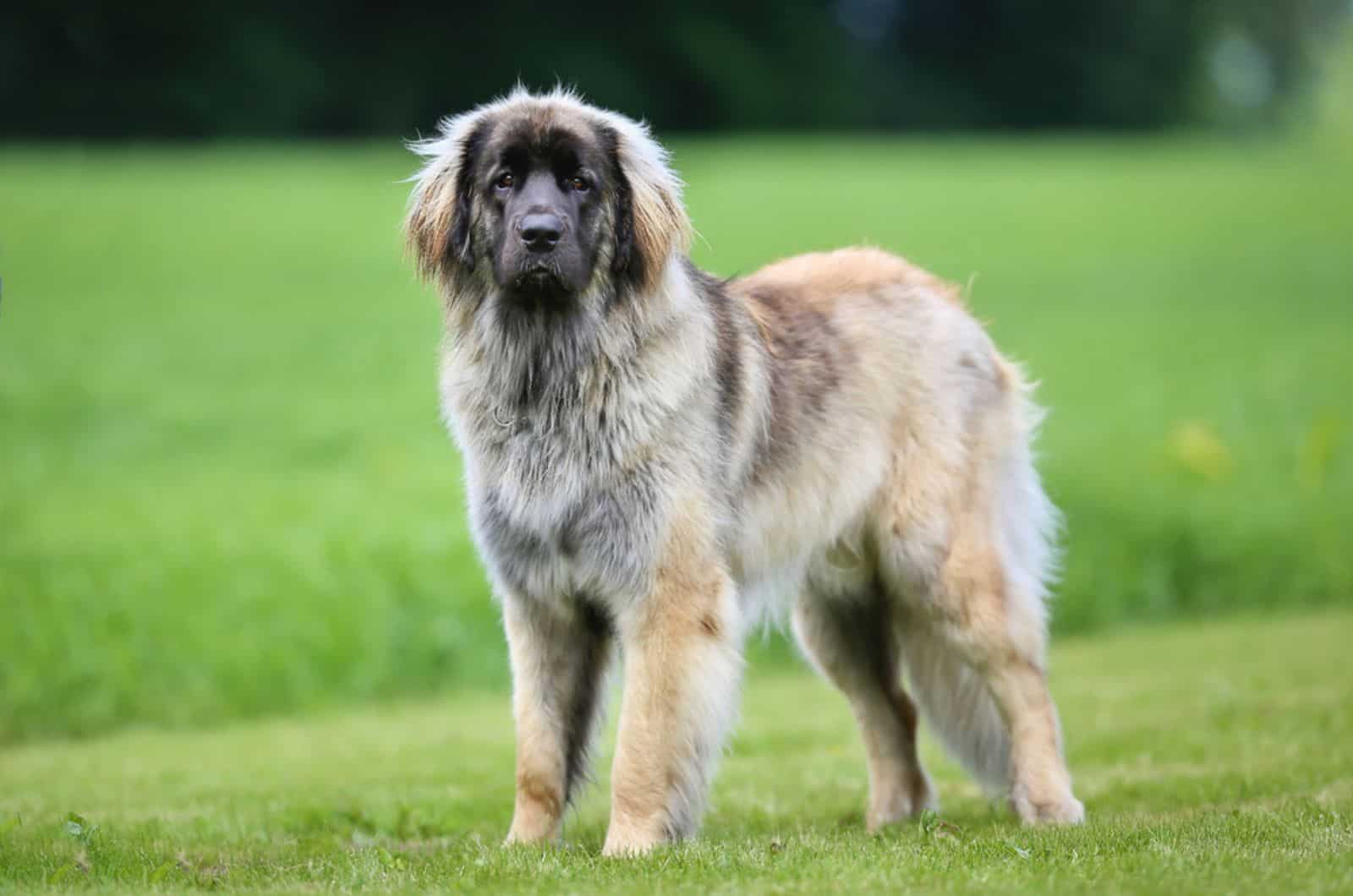The Leonberger, or the Leo, is a large, muscular and strong dog that was bred in Germany in the middle of the 19th century. The origin of this dog is linked to three different dog breeds: St. Bernard, Newfoundland, and the Great Pyrenees.
At the beginning of the appearance of the breed, these dogs became very popular and many people from a respectable part of society owned them.
However, during the First World War, these dogs were even threatened with extinction, since many people could not feed and provide decent living conditions for this large dog.
Fortunately, this dog did not disappear and still exists today – admittedly, it is quite rare, but extremely valuable and a special dog.
The Leonberger is a loyal and playful dog that learns quickly and is easy to train. When you see this dog, it’s clear that it’s a large and strong dog, but do you even know how much this dog should weigh and how tall it should be?
If you are not familiar with the details of this dog’s breed and would like to know more, you are in the right place. In the following text, we bring you a detailed Leonberger growth chart.
Leonberger Growth Chart 101
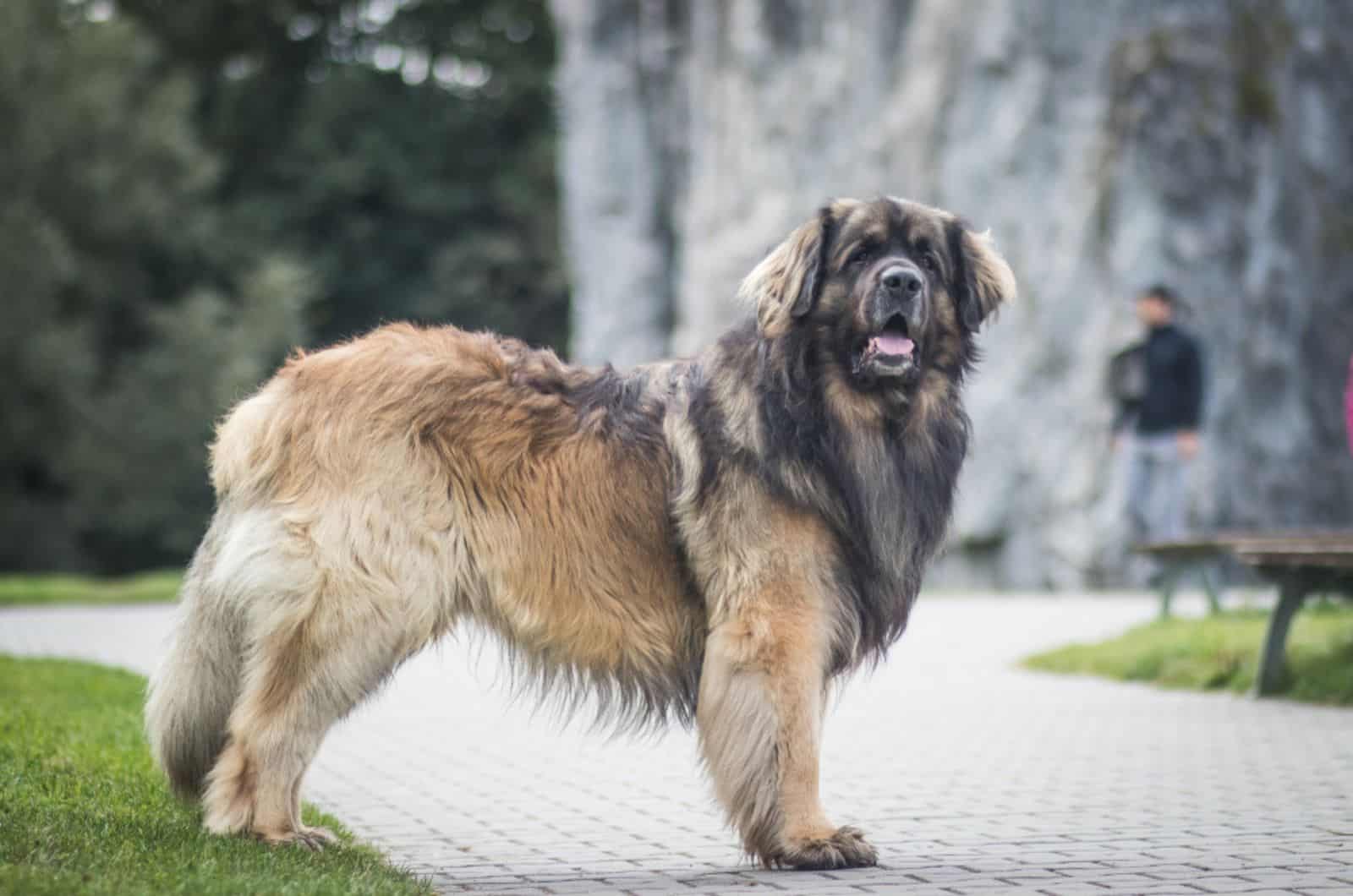
To fully understand the Leonberger dog weight, it is good to know the average weight of all three dog breeds this dog originated from.
According to the Newfoundland growth chart, the male Newfoundland weighs 130 to 150 pounds, while females are slightly lighter, with the average weight of 100 to 120 pounds.
Saint Bernard’s growth chart indicates that the males should weigh 140 to 180 pounds, while females should be a bit smaller and weigh 120 to 140 pounds.
Finally, a Great Pyrenees is another large dog, weighing 85 pounds and up. So, one thing is sure; the Leonberger is also a large breed!
Now, we will see how much a Leonberger puppy is supposed to weigh at different developmental stages.
Let’s look at the basic Leonberger growth chart.
[table id=703 /]
Each dog has a certain breed standard that describes the recommended weight for all stages of the dog’s development. As we could see in the Leonberger weight chart, not every Leonberger dog weighs the same.
Even dogs of the same breed differ in weight, but these are usually small variations – if the dog is well below the desired weight, this means that it is malnourished, and if it is far above the recommended weight, this indicates that the dog has an obesity problem.
Therefore, it is essential that every dog owner knows how much their dog should weigh at each age.
If your dog deviates from the desired values, you should not worry if the deviations are minor. Various factors affect the weight of a Leonberger, and we will also clarify them later in the text.
Regarding the Leonberger height, male dogs are 28 to 31.5 inches tall, while females’ height goes from 25.5 to 29.5 inches.
Which Factors Affect The Leonberger’s Size?
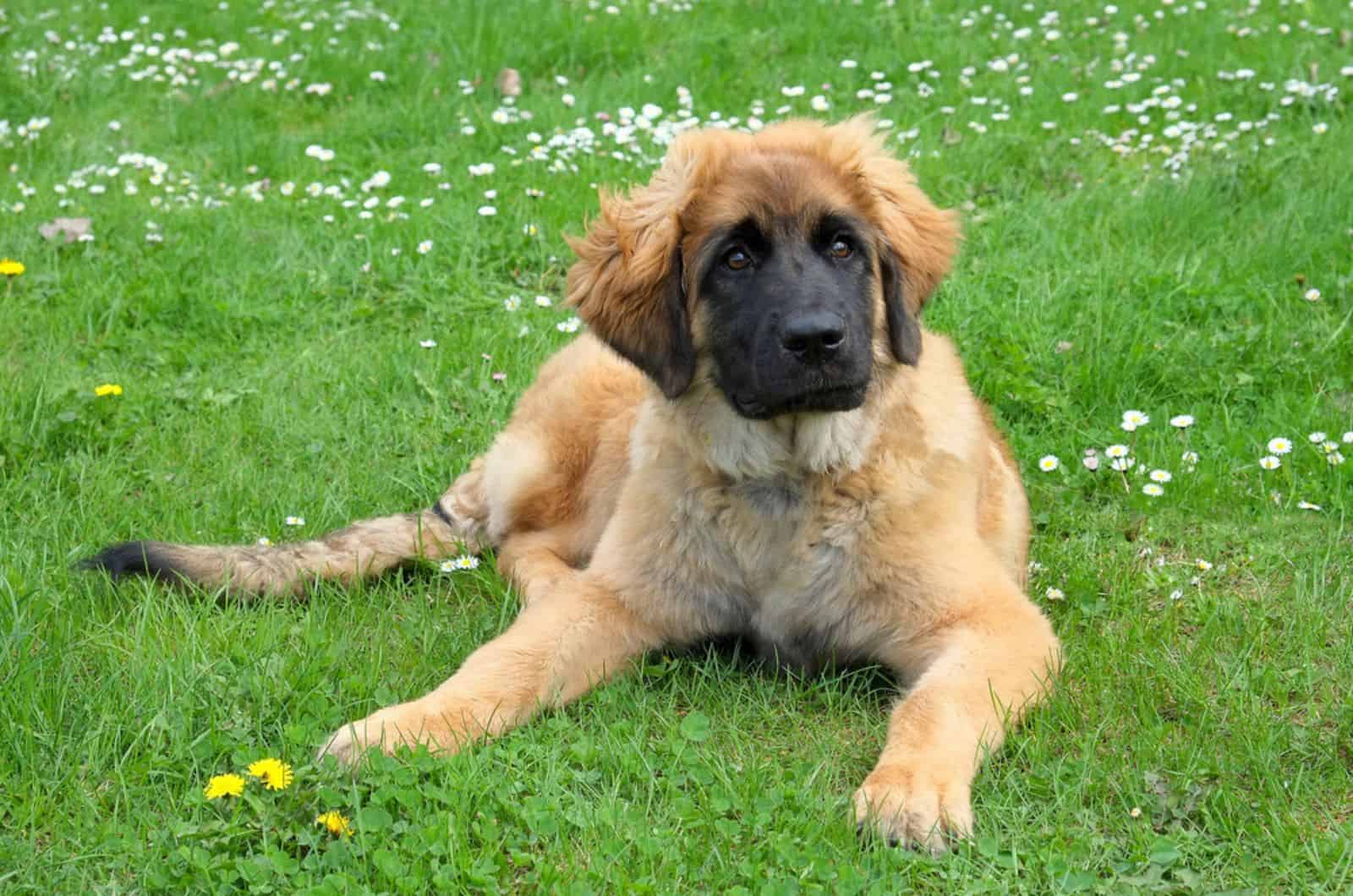
Since not all Leonbergers weigh the same, there are certain factors that determine the final size of this dog. So, if you would like to accurately estimate the future weight of your Leonberger, you should take the following factors into account.
1. Gender
Female Leonbergers will usually be slightly smaller than their male counterparts.
If you don’t have a gender preference, both male and female Leonbergers are equally good pets and watchdogs.
However, if you want your dog to be bigger and more muscular, the male Leonberger is a better choice for you. In some dogs, there are no major differences between the sexes, and the gender does not affect the size of the dog, but this is not the case with the Leonberger.
2. Nutrition
Dog food is essential for every dog’s health, and it is especially important with large dogs like Leonberger.
Leonberger’s diet should include proteins, healthy fats, vegetables, and vitamins and minerals that are beneficial for a dog’s health.
Since this dog is large and active, it needs high-quality food that will be its fuel for everyday activities. When this puppy begins the transition from baby food to solid food, it should have four meals per day.
As the dog grows up, its meals should be reduced to three times, and finally to two times a day, when the dog is fully grown up.
The food you give your Leonberger will greatly impact this dog’s size. A dog that eats quality food will grow up to be a healthy dog with optimal body weight, while a dog that eats too much or eats low-quality dog food might develop obesity.
The Leonberger should eat dry food and raw food. Learn more about how much raw food to feed a puppy.
Some human food, like fruits, cooked eggs, and cottage cheese, will also be beneficial for your dog’s growth, but you should not exaggerate with giving these kinds of food to your dog – dog food should be your first choice in your dog’s nutrition.
Proteins should be the main part of your dog’s diet – they can be found in brown rice, lean chicken, and turkey. Eating food of this kind will promote the healthy growth of your dog’s muscles and joints, and therefore, your dog will be gaining healthy weight for its age.
3. Activity Level
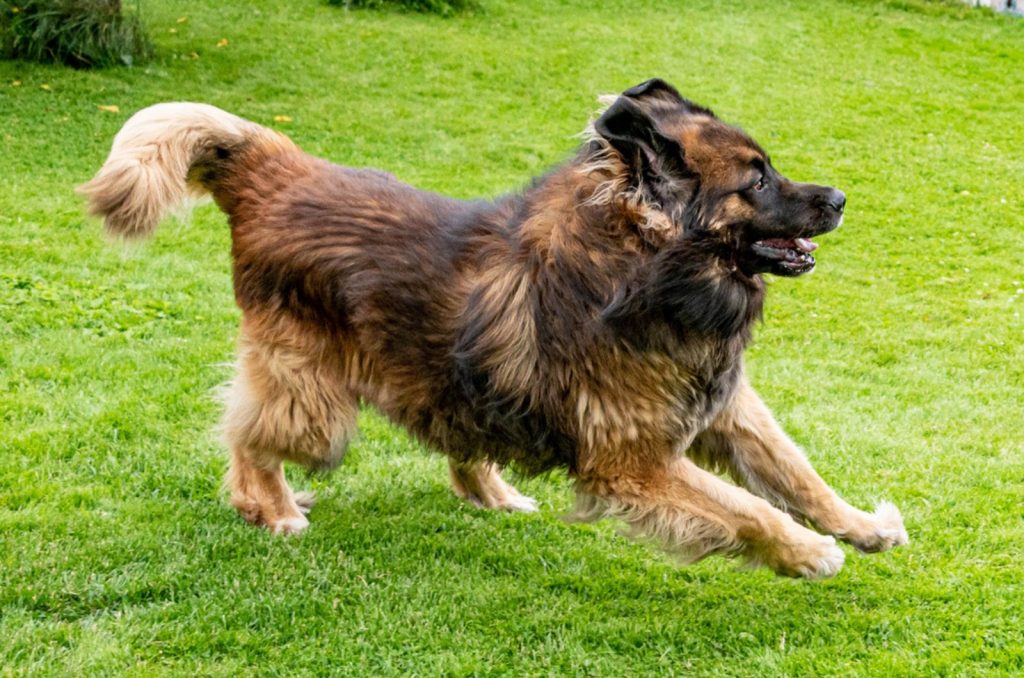
Physical activity is vital for all dogs, but especially with large dogs like Leonbergers. Regular exercise will help your dog grow up to be a healthy dog with optimal body size, and will help it develop strong bones and muscles.
What is the perfect amount of exercise for Leonbergers? Well, these dogs need at least an hour of exercise a day. This should include long walks, runs, or swimming, as Leonbergers are very good swimmers. This dog will also enjoy other activities such as running or hiking.
Exercise is a very important factor for the Leonberger’s size, and what is even more important is that the exercise is started on time – that is, not too early.
Exercising, jumping, and running is crucial for a dog’s health, but these activities should not be overdone while the dog is still developing.
Excessive physical activity while the Leonberger is still very small can negatively affect the development of his muscles. It would be best to consult your veterinarian about the ideal amount of exercise for each developmental stage of your Leonberger.
4. Genetics
How big do Leonbergers get also depends greatly on the dog’s genetics. So, looking at your dog’s parents might give you a fair insight into how your puppy will look when it grows up.
Reputable Leonberger breeders will show you the genetic tests and your future puppy’s parents photos themselves – so, you should only buy dogs from breeders of this kind.
Of course, some Leonberger puppies will be bigger than their parents, but, in general, it is an essential factor that influences the dog’s health in general, and its appearance and size.
5. Neutering/Spaying
Sterilization of a dog can have a positive effect on calming destructive behavior in our pets, but, according to some opinions, this procedure can negatively affect the growth and development of the dog.
The ideal age for sterilization differs among dog breeds, so, smaller dog breeds are recommended to be sterilized at an earlier age than large dogs.
This is a particularly sensitive topic with Leonbergers. Although these dogs are large, and they can be huge already at the age of one year, they mentally mature much later, therefore, it is not recommended to sterilize them too early.
Sterilization can also change the dog’s eating habits, so a sterilized dog may seek more food and move less, which will affect the formation of excess weight.
This is of course not a rule with all dogs. Any veterinarian will advise you on the proper care of your dog after sterilization, as this is a routine procedure that should not pose any threat to your pet’s health.
When Is A Leonberger Considered To Be Fully Grown?
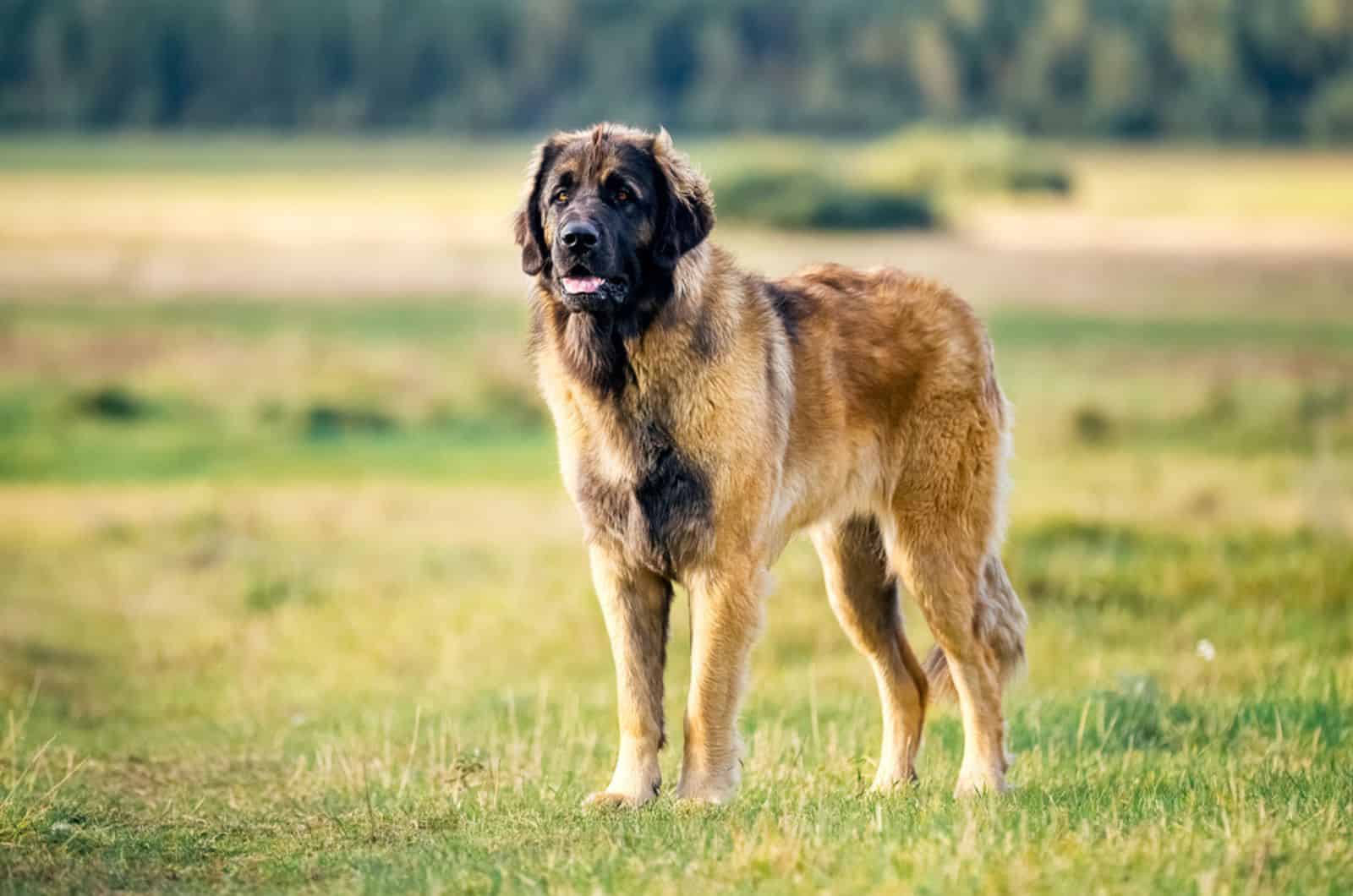
The Leonberger reaches its full size around 18 months of age. Males might still continue to grow after this period, since they are bigger, and they need more time to fully develop. So, some Leonbergers might be fully grown when they are 2 years of age.
This goes for the Leonberger’s physical size, while these dogs will reach full mental maturity only around the age of three.
So, it is very likely that you will have a huge dog that will still act like a young puppy! If you are wondering when puppies become easier – you could wait a long time with a Leonberger, but with proper training and socialization, this dog will be your perfect furry friend!
How To Keep Leonberger’s Optimal Weight?
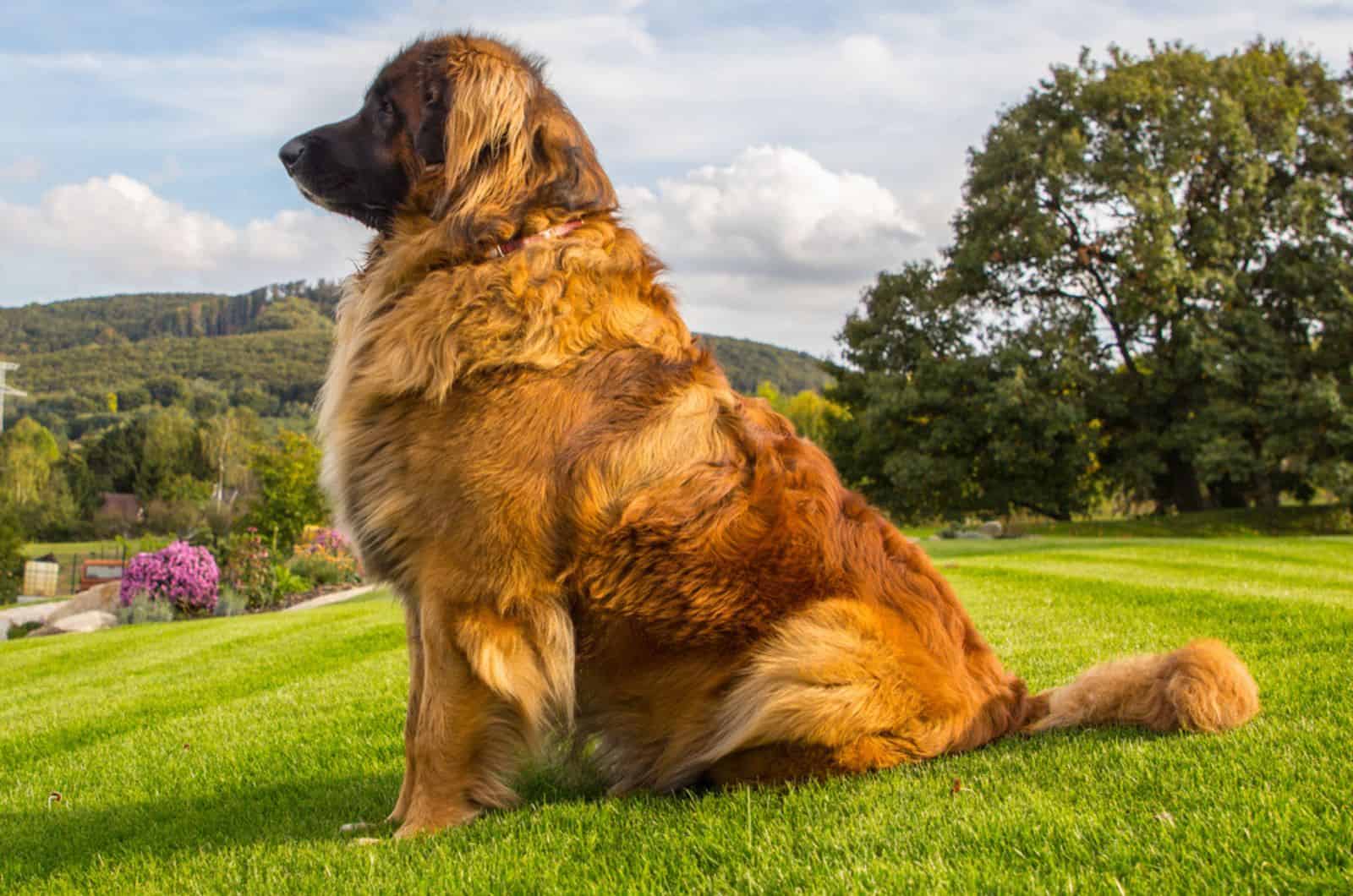
Leonbergers are large canines that were bred to be farm dogs and family companions. When you see a dog this big, you probably immediately wonder how to keep this dog at optimal weight.
Well, the most important thing with these dogs is to provide them with high-quality dog food.
Also, you should not leave food available to this dog all the time – from the moment this puppy comes to your home, you should establish a puppy schedule that will help you create a sleeping, exercising, and feeding routine for your dog.
Together with dog food, regular exercise will be one of the most essential steps for maintaining a healthy puppy weight.
Leonbergers can not only be obese – some of these dogs might be malnourished, which can be noticed by the dog’s lethargy, frequent infections, and you will probably see a pronounced rib cage in dogs, which is not the case in dogs with a normal body weight.
Obesity and malnutrition are very bad for a dog’s health, so if you notice that your Leonberger deviates significantly from the breed standard, you should consult your veterinarian about a potential change in the dog’s diet or other steps to address your dog’s weight problem.
Leonberger’s Lifespan & Health Issues
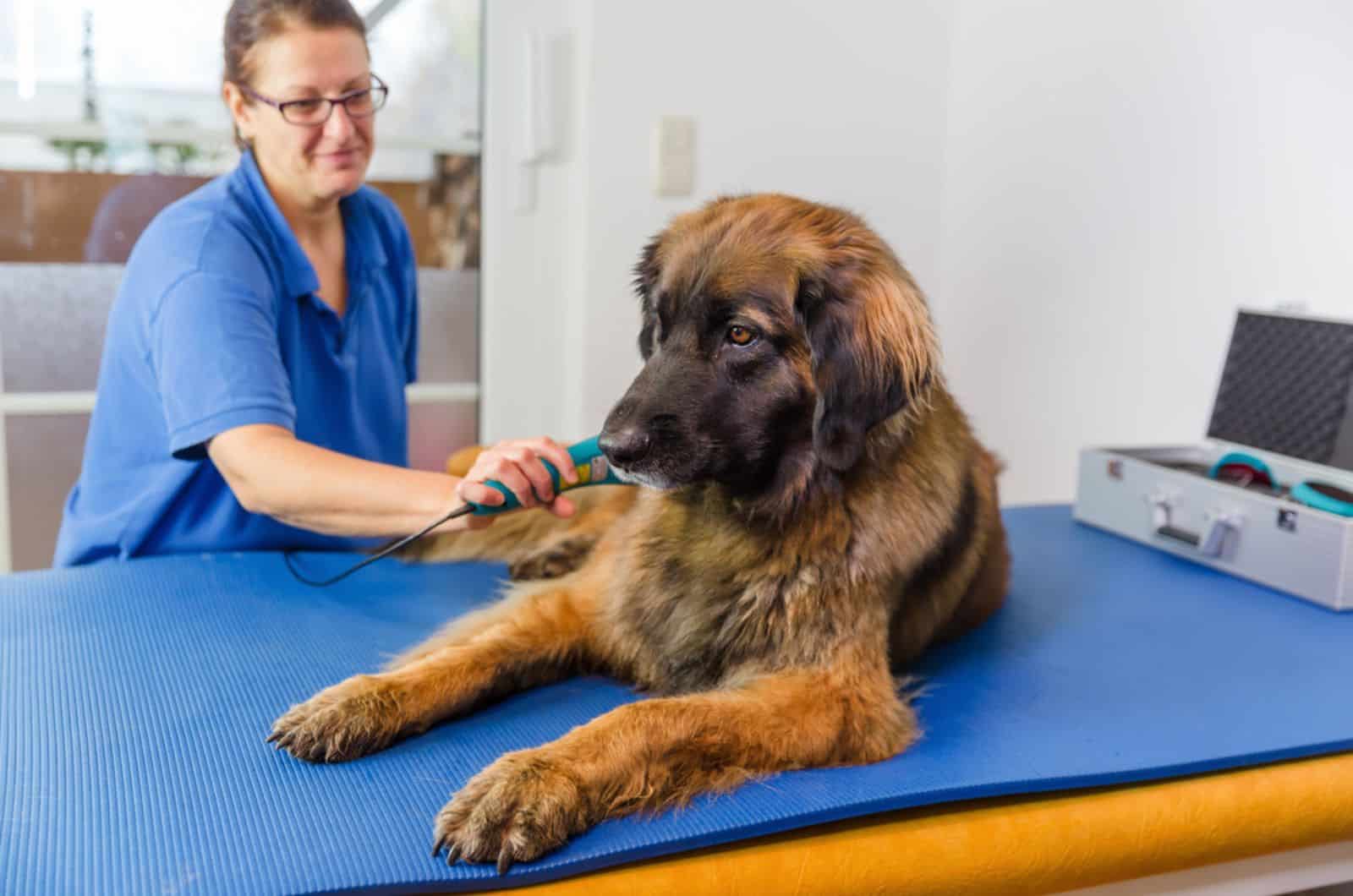
Larger dogs generally have a shorter lifespan than smaller dogs, and this is also the case with the Leonberger. The expected lifespan of these dogs is from 7 to 9 years.
But, no matter how many years you spend with this wonderful dog, you will have a companion for all your adventures and a family dog that your children will love to spend their days with.
Along with their short lifespan, Leonbergers are also prone to certain health problems, some of which are directly related to this dog’s size. Therefore, it is important to take this dog to regular veterinary examinations, give him high-quality food, and provide him with enough exercise.
Let’s take a look at some of the health problems that Leonbergers might struggle with.
1. Bloat
Gastric Dilatation Volvulus or bloat, is a condition of progressive expansion of the dog’s stomach, which manifests in severe pain, reduced blood supply, and significantly reduced activity in dogs.
Bloat causes food and gas to put pressure on the dog’s stomach walls and prevent it from functioning normally.
Stomach twist in dogs can be caused by excessive eating, improper eating habits, bad positions of the dog while eating, as well as eating a large amount of dry food that is not adapted to the dog’s age.
Bloating in dogs can be noticed by a swollen belly, pale gums, weakness and complete exhaustion of the dog. A dog with this condition may not even be able to move, and will try to vomit, but without success.
Bloat can be dangerous for the dog’s life if it is not treated in time, therefore, it is necessary to immediately contact the veterinarian as soon as you notice the previously mentioned symptoms.
2. Hip And Elbow Dysplasia
Hip and elbow dysplasia are quite common orthopedic diseases in dogs.
Hip dysplasia refers to the abnormal development of the pelvic bones and the head of the femur in a dog. This disease leads to weakened hip function, which significantly impairs the dog’s mobility and its overall quality of life.
Hip dysplasia is a hereditary disease, but its appearance can also be influenced by environmental factors, such as accelerated development, excessive physical activity of a young dog, and obesity.
Most dog owners notice symptoms of hip dysplasia in their pets between the ages of 5 and 12 months.
If one or both parents suffer from hip dysplasia, this does not necessarily mean that their offspring will inherit the disease, but certainly that their dogs have a significantly higher chance of developing this disease than other dogs.
Hip dysplasia can be noticed by the dog’s limp, or the dog’s refusal to climb stairs, as this will be very painful for a dog with dysplasia.
Elbow dysplasia occurs when the cartilage in the dog’s joint develops improperly and interferes with elbow movements. Like hip dysplasia, elbow dysplasia occurs during the dog’s development process, that is, between 4 and 10 months of age.
Depending on the severity of the cases, the veterinarian will prescribe the appropriate treatment, and some dogs will require surgery.
3. Panosteitis
Panosteitis is a disease of the locomotor system of dogs in growth and development, therefore, it is a disease of young dogs whose skeleton is still developing. This disease occurs more often in larger dogs like the Leonberger than in small dogs.
Panosteitis is an inflammatory process on the lining of tubular bones in dogs, which is very painful for dogs. A dog with this disease will have difficulty moving, will limp, and the pain can also spread to other extremities.
It is very important to detect this disease early, so that the veterinarian can prescribe the appropriate therapy as soon as possible. Therapy for panosteitis includes analgesics and anti-inflammatory drugs.
When the disease is detected in time, it is possible to avoid atrophy of the dog’s musculature.
In a large number of cases, the symptoms of panosteitis disappear on their own as the dog grows up. However, in some cases, if the disease appeared when the dog was very young, it is possible that it results in delayed growth and development of the dog’s skeleton.
FAQs
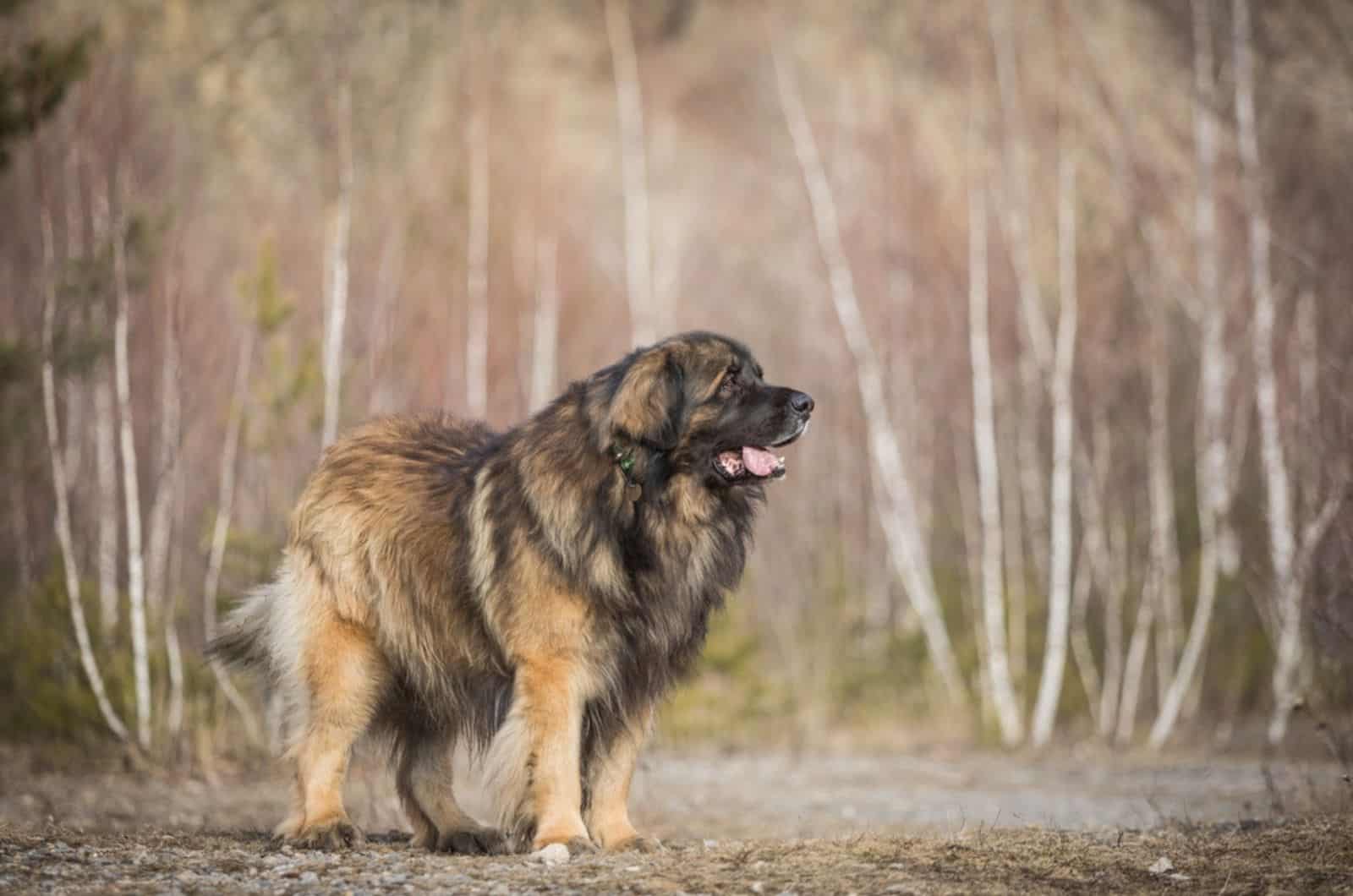
The recommended time for sterilizing a Leonberger is at the age of 6 to 9 months. With every dog, it is possible to clearly notice signs that it needs to be neutered, and if you do not want your dog to reproduce, it is definitely advisable to perform this procedure.
Sterilization will prevent unwanted pregnancy in the dog, and will reduce unwanted behaviors. However, it is not recommended to sterilize the dog too early, due to the influence of hormones on the dog’s further growth and development.
If you intend to sterilize your dog, it would be best to consult with your veterinarian about the best age for this procedure.
At the age of 5 months, male Leonberger puppies should weigh 55 to 79 pounds. Females will usually be slightly smaller and will weigh 51 to 64 pounds.
Some dogs could weigh less than these recommended values for the age of 5 months, but, this does not mean that there is something wrong with them. It is possible for a dog to gain weight slower than other dogs of the same breed, but still it can be perfectly healthy.
Of course, if you notice that it significantly deviates from the recommended weight, you should consult a veterinarian.
Leonbergers are extremely kind and gentle, and this is why these dogs make wonderful family pets. They are large dogs, but still adore spending time indoors with their family members.
Also, these dogs love to be around humans, especially around children, all the time. They are calm and quiet, and also make great therapy dogs.
These dogs need a lot of interaction with their people to be satisfied. They can also get along well with other pets, but when they are socialized and trained from a young age.
Leonbergers are a wonderful choice for active people who prefer large dogs with gentle hearts. Future owners should be aware that these dogs do not like to be left alone for longer periods of time.
So, owning a Leonberger means serious commitment, but also brings you a furry best friend for years.
The Leonberger has a medium-long, water-resistant double coat, which can be wavy or curly. This dog should have a so-called black mask, which means it should have a black muzzle that can extend to the dog’s ears.
This dog’s fur can be medium soft to coarse. The golden-yellow or red-brown color of the Leonberger’s coat makes this dog very similar to a lion. The outer part of the Leonberger’s coat is dense and short, while the undercoat has a more fluffy texture.
It is recommended to brush this dog’s coat often, even daily, since it is prone to matting.
Leonbergers need to be regularly groomed to get rid of all of the dirt from this dog’s coat, and to keep the coat mattes and tangles free.
Also, this dog will look stunning when his coat is properly taken care of! Regular brushing will also help you check whether there are any skin problems, cuts, or injuries on your dog’s fur and skin.
Grooming time is a perfect time for a dog owner to bond with his Leonberger. Besides regular brushing, all dog owners should also bathe their dogs, trim their nails, and clean their eyes and ears.
Just like with us humans, hygiene is very important for dogs. Regular hygiene has a significant positive effect on the health of our dog and extends its lifespan.
In caring for our pets, it is very important that we use quality tools and preparations – for example, you should never use human shampoo or conditioner when bathing your Leonberger.
There is no exact way to predict how big your dog will be. Of course, there is a breed standard that shows you how big approximately your Leonberger puppy will get.
Also, you can learn a lot about your dog’s future size by looking at your dog’s parents. Since genetics is an essential factor of every dog’s size, your puppy is likely to look like its parents.
One thing is sure with Leonbergers; these are large dogs with gentle hearts!
Conclusion
It is clear to every dog lover that the Leonberger is a large dog, but future owners of this dog should be a little more familiar with the weight and appearance of the Leonberger.
For this reason, we have provided you with a Leonberger growth chart so that you know what to expect during the development of this dog. The Leonberger is a large and powerful dog that needs a high quality diet and plenty of exercise to keep it healthy and happy.
Since this dog needs a lot of food, many of them can become obese if their owners feed them low-quality food, or inappropriate food for their age, and if they do not get enough exercise.
Also, the Leonberger can be malnourished if he does not get adequate food, or if a certain health problem is hidden behind the dogs’ weak appetite.
We hope that our analysis of the expected weight of a Leonberger will be helpful, and if you have any additional questions about the size, diet, or health of this dog, it would be best to consult a veterinarian.
This big dog is not the best choice for first-time dog owners, since it requires a lot of care, space, and effort to grow up to be a well-behaved and a healthy dog.
However, we find it as a dog with wonderful traits for experienced dog owners, so, if you have already possessed a dog with similar size as the Leonberger, we bet you will be great in keeping this dog healthy, happy, and with optimal body weight!
